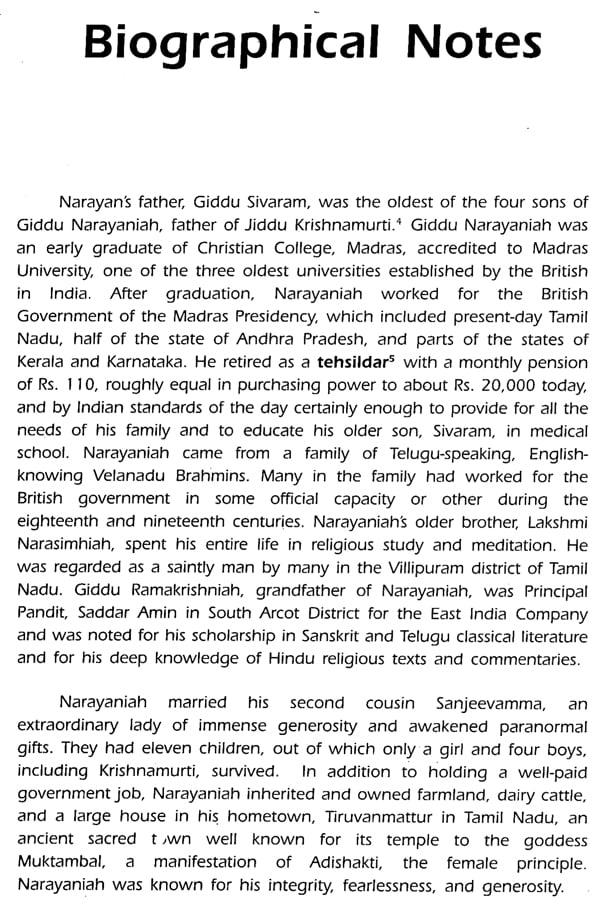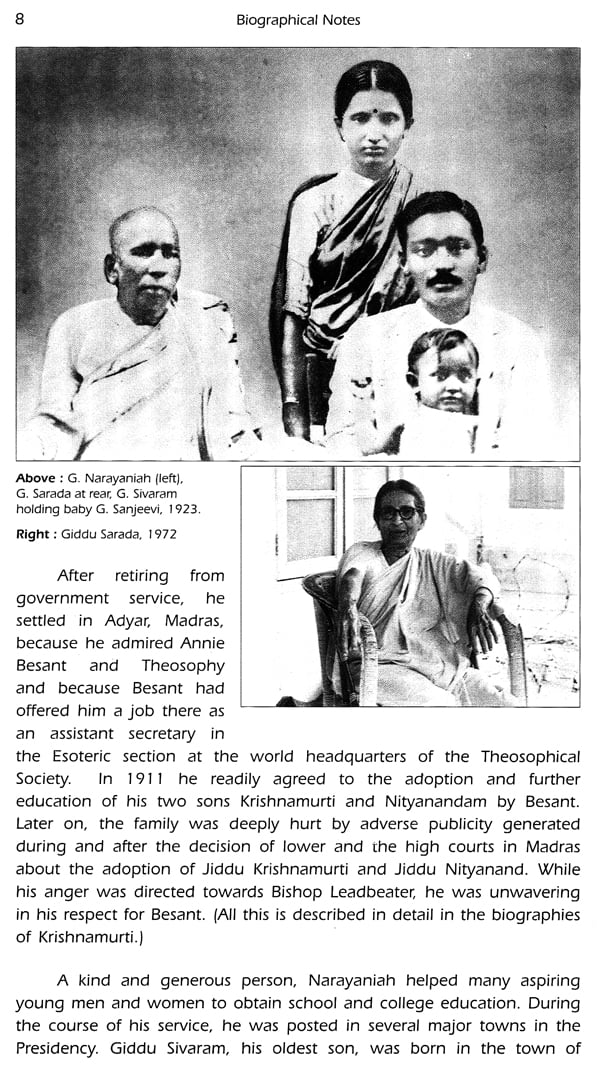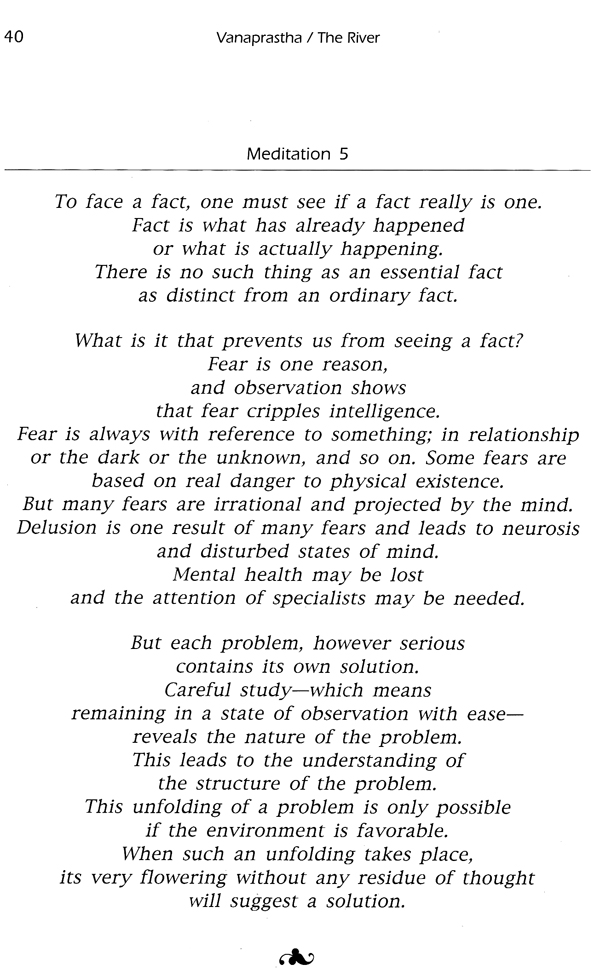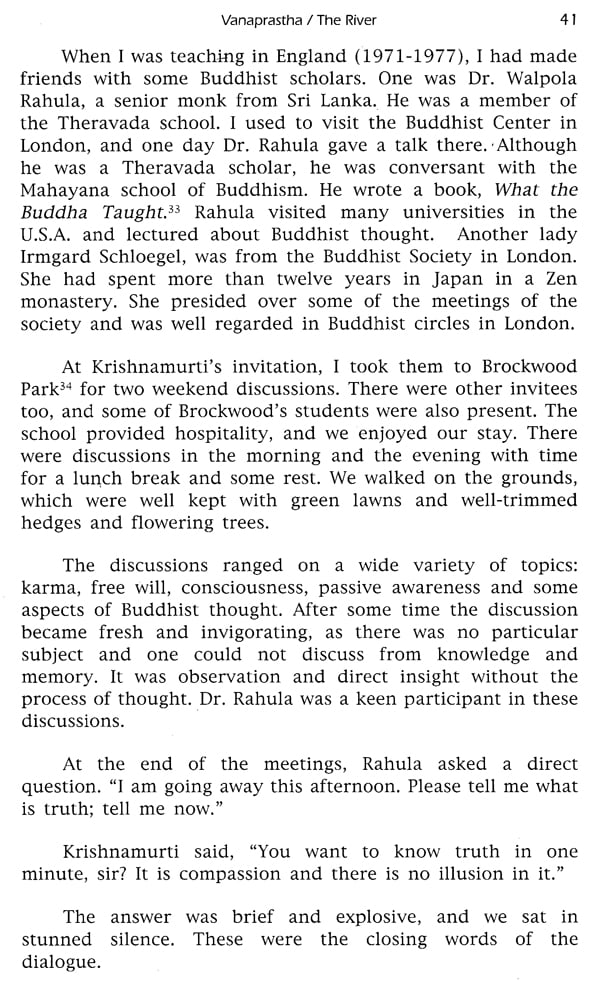
As the River Joins the Ocean
Book Specification
| Item Code: | NAX843 |
| Author: | J. Krishnamurti |
| Publisher: | Book Faith India |
| Language: | English |
| Edition: | 1998 |
| ISBN: | 8173031789 |
| Pages: | 92 |
| Cover: | PAPERBACK |
| Other Details | 8.50 X 5.50 inch |
| Weight | 240 gm |
Book Description
Giddu Narayan was an exceptionally gentle and cheerful human being who, like many others around Jiddu Krishnamurti, unreservedly gave his whole life and energy to the study of the teachings. There were three primary ways in which Narayan perceived his teacher. First, and like most Indians of his generation, Narayan always regarded Krishnamurti to be a World Teacher, one who points the world towards freedom from all illusions, especially the illusion that tempts us to find that freedom through another person. Second, as a man who had spent over thirty years teaching school, Narayan recognized Krishnamurti as a rare and exceptional teacher who shared his insights about exploring different paths to right education with those who gathered around him with the same urgent concern. Narayan's reminiscences are continually imbued with these two perceptions. But the third, mystical perception of Krishnamurti that shines through the reminiscences was as real to Narayan as were the other two. In my association with him, as brother-in-law, dear friend, and wise counselor, I saw that to him Krishnamurti meant all three things at the same time, and these three facets were never ever separate from each other.
It is this holistic perception of Krishnamurti that is the common thread in Narayan's writing which makes his reminiscences fascinating and extremely important as historical resource for posterity.
In addition to the biographies of Krishnamurti by Mary Lutyens and Pupul Jayakar,' other articles, memoirs, and recollections have been published, and each one, as Narayan said, "has to stand the rigorous test of time." He had either read or was familiar with these works. But as he told me, even if a thousand individuals who considered themselves close to Krishnamurti were to write their memoirs, it would be impossible to answer the question "Who is Krishnamurti?" with certainty. To Narayan, however, this was never a problem. He wrote his reminiscences to clarify his own perception of his teacher - a page a day, at Vasanta Vihar in 1989, three and a half years after Krishnamurti had passed away.
They come through as transparently real, original, deeply felt, and important for any student of the teachings. Those who knew Narayan and had met Krishnamurti may get some help from these reminiscences in their quest to find their own answers to "Who is Krishnamurti?"2
In sharing his observations as a silent witness over thirty-five years, Narayan provides the general reader with a brief but sharp introduction to Krishnamurti, within which a barely visible and austere memoir of his own life becomes apparent. More significantly, it becomes clear that from the time he met Krishnamurti to the end of his life, Narayan thought of himself as no more than one of the many serious students of Krishnamurti's teachings.
When the project of this book was discussed, Narayan agreed with me that for archival reasons it was necessary to interpolate some relevant information about his life and family background. These, he sent word to me through his sister Indira, my wife, must only provide narrative continuity and a chronological framework, within which I was free to rearrange his reminiscences. He was emphatic that his observations and descriptions of his meetings with Krishnamurti should be left unaltered or minimally edited. He realized that some names, places, and words mentioned by him in various contexts of his meetings with Krishnamurti would not be familiar to a general reader and that explanatory notes would be helpful. Based on notes that I took when I last met him in 1995, I have provided both parenthetical interpolations and end notes. Also, I have left 'Krishnaji' as it is wherever it occured in Narayan's manuscript, but used 'Krishnamurti' when it was mentioned as 'K'.
Following Narayan's instructions, I have generally used Dr. S. Radhakrishnan's translations of the Brahmasutra, the Dhammapada, and the Bhagavadgita and his other works to provide meanings and explanations for Sanskrit words and phrases in addition to using English translations of Sanskrit works published by the Ramakrishna Mission and the Ramanashram.
Narayan's meditations have been added to the beginning and ending of each section of the memoirs because they reflect his inner life and show how deeply he was imbued with the teachings.
My hope is that this little book, when read along with other books and the twenty million or more words in the Krishnamurti teachings, may illuminate additional insights into Krishnamurti, who clearly stated in February 1986, "You won't find another body like this, or that supreme intelligence operating in a body for many hundred years."3
I am very grateful to Narayan's mother Sarada, and to his sister and brother Dr. Uma Ramaswamy and Giddu Krishnamurti, as well as to Indira, Natasha Narayan, Pampa Narsipur, Eddie Ani, and friends of Narayan for their active assistance and encouragement in publishing this book. I would like to thank the Krishnamurti Foundation of America and Mrs. Evelyne Blau for their hospitality at Arya Vihara, Ojai, California when we were editing the final manuscript; to Debra Case and Deborah Garber of the Avon Old Farms School Library for extensive use of the school's computers over many months; to Rita Zampese for rare photographs; to James Paul and Kendra Burroughs for expert help in editing, proof reading, and thoughtful comment; to Vikram Parchure for inspired art work and design; and finally to Edwin House for its unwavering interest in keeping its word to Narayan that his reminiscences would be published.
**Sample Pages**










